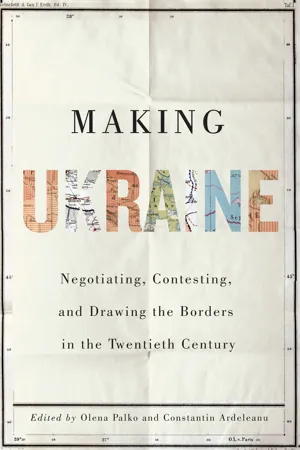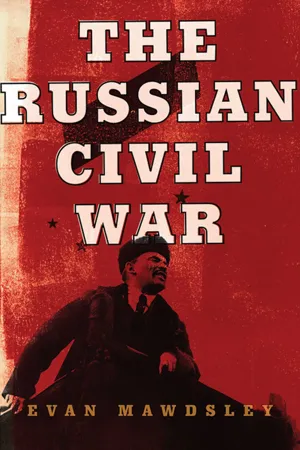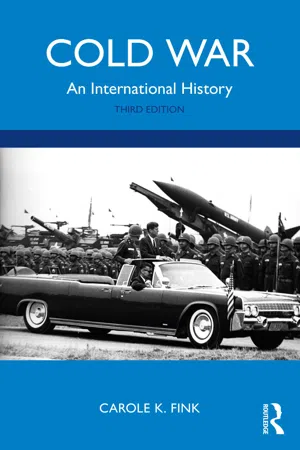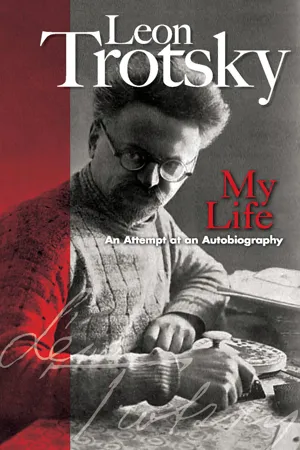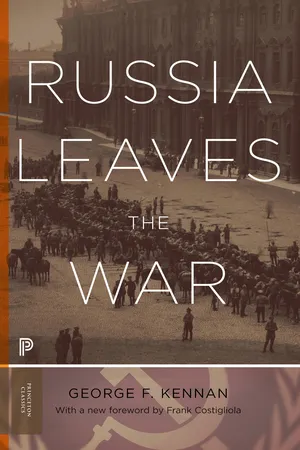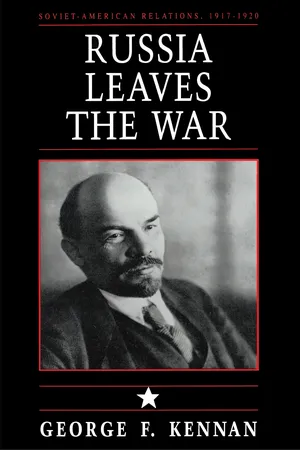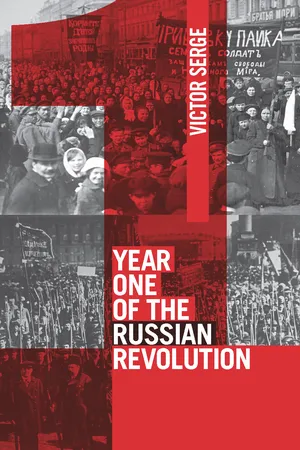History
Treaty of Brest-Litovsk
The Treaty of Brest-Litovsk was a peace treaty signed in 1918 between the Central Powers and Soviet Russia, effectively ending Russia's involvement in World War I. The treaty resulted in significant territorial losses for Russia, including the ceding of large portions of land to Germany and its allies. This treaty allowed the Central Powers to focus their efforts on the Western Front.
Written by Perlego with AI-assistance
Related key terms
8 Key excerpts on "Treaty of Brest-Litovsk"
- eBook - ePub
Making Ukraine
Negotiating, Contesting, and Drawing the Borders in the Twentieth Century
- Olena Palko, Constantin Ardeleanu, Olena Palko, Constantin Ardeleanu(Authors)
- 2022(Publication Date)
- McGill-Queen's University Press(Publisher)
Ukraine’s Borders at the Brest-Litovsk Peace Conference , 1917–18Borislav ChernevAt two o’clock in the morning on 10 February 1918, representatives of the Central Powers (Germany, Austria-Hungary, the Ottoman Empire, and Bulgaria) signed the first peace treaty of the First World War at the half-burnt Russian fortress of Brest-Litovsk on the Bug River. This was not in the presence of their Russian counterparts, however, but with representatives of a brand-new state, the Ukrainian People’s Republic (UNR). The treaty’s provisions would be null and void within a year. “The wheel of history crushed it,” Pavlo Khrystiuk, a contemporary politician and early historian of the Ukrainian Revolution, would later remark, “[but this] does not lessen [its] importance … in the history of the Ukrainian people’s struggle for national liberation and nation building.”1The importance of the First Treaty of Brest-Litovsk for modern Ukrainian statehood is undeniable, and the fact that it came to pass is quite extraordinary. When the war began, no one foresaw the emergence of an independent Ukrainian state; as late as January 1917, almost no one did. Yet within months of the collapse of the imperial regime in Petrograd in February 1917, an autonomous and eventually fully independent Ukrainian republic had been established in the southwestern part of the defunct Russian Empire and was making bold territorial claims to the Ukrainian-speaking areas of neighbouring Austria-Hungary.This chapter argues that the Brest-Litovsk Peace Conference played an important – and somewhat underappreciated – role in the making of Ukraine’s contemporary borders. Border-making, which began at Brest-Litovsk and culminated at the Paris Peace Conference of 1919–20, was crucial to the process of territorializing ethnicity in East-Central Europe. The drawing of Ukraine’s western borders at Brest-Litovsk proved particularly problematic, for Ukraine’s national claims clashed with those of neighbouring Poland over the Kholm region and Habsburg-controlled Eastern Galicia. The negotiations also required the creation of a mental as well as physical map of Ukraine. This meant that by the end of the conference, the fledgling state had entered the European popular imagination with specific – if subject to constant revision – borders based on ethnic lines, an indispensable - eBook - ePub
- Evan Mawdsley(Author)
- 2009(Publication Date)
- Pegasus Books(Publisher)
3 When the Soviet delaying tactics failed, when the Germans increased their demands and resumed their advance, Lenin threw his entire reputation into the debate. On 23 February, five days after the German offensive, he threatened to quit the CC and Sovnarkom if the final terms were not accepted. Given his prestige, given the support of senior leaders such as Zinoviev, Kamenev, and Stalin, and given the enemy’s successes, Lenin had his way. A new Bolshevik delegation agreed to the February terms and signed the Peace of Brest-Litovsk on 3 March 1918; in a last futile gesture of revolutionary principle they refused to formally read the document.The final terms of the Treaty of Brest-Litovsk were, from the Russian point of view, a combination of dismemberment and emasculation. The Bolsheviks accepted a vast amputation of territory—one unprecedented in great-power relations. Russia completely gave up Poland, Lithuania, and western Latvia. She agreed to make peace with the Ukrainian nationalists, in effect recognizing the Ukraine as an independent state. Russian forces were to be pulled out of Estonia, western Latvia, Finland, and the southern Transcaucasus, and the implication was that these territories could and would decide to break away from the Russian state; in fact they were to be occupied by the Central Powers’ troops. Russia also had fully to demobilize her army and refrain from any agitation or propaganda; the first point had little practical effect, but the second seemed to rule out the revolutionary propaganda that the Bolsheviks considered so important.In the eyes of the leadership—including Lenin—the acceptance of the Brest terms was only a temporary setback, dictated by weakness. But the future would show that the decision made by the Bolshevik leadership on 23 February 1918 had been a sea change. Revolutionary dreams had been abandoned for diplomatic reality. Although European revolution was a major Bolshevik objective in 1919 and 1920, the program had lost its original purity. Symbolic of the immediate defeat was the transfer of the capital to Moscow; Petrograd was now too exposed to attack. (Before October the Bolsheviks had pilloried Kerensky for wanting to give up the Baltic capital.) Lenin’s famous arrival at Petrograd’s Finland Station in April 1917 was now followed by its ignominious consequence, his departure during the night of 12 March from the Tsvetochnaia Ploshchadka, a freight depot in the southern outskirts of Petrograd, well out of the public eye. Protected by Latvian Riflemen, the only reliable troops the Bolsheviks had, Lenin and the government train left for the interior. - eBook - ePub
Cold War
An International History
- Carole K. Fink(Author)
- 2021(Publication Date)
- Routledge(Publisher)
Russia’s former allies moved swiftly to counter Bolshevik propaganda. In January 1918 British premier David Lloyd George and US president Woodrow Wilson each enunciated their nations’ war aims in ringing and idealistic terms. In particular, Wilson’s Fourteen Points provided a democratic and capitalist alternative to Lenin’s dramatic appeal to the world by calling for open diplomacy, global disarmament, freedom of the seas, border adjustments based on national claims, and an international organization to secure the peace.The Central Powers’ reaction was harsher. Driving deeper into a devastated Russia and impervious to Leon Trotsky’s audacious “no war – no peace” stratagem, in March 1918 the German military extracted a punitive peace at Brest-Litovsk. This treaty eliminated Russian power from Europe, creating a string of puppet states in the western part of the former tsarist empire and establishing German control over vast amounts of its agricultural and mineral resources. A jubilant German Reichstag (parliament), ignoring its 1917 Peace Resolution and the Bolsheviks’ protests over a dictated treaty, ratified Brest-Litovsk by an overwhelming majority, with the opposition Social Democrats merely abstaining.The Bolsheviks’ diplomatic debut at Brest-Litovsk established important precedents for future relations between Soviet Russia and the West. Among them was the introduction of Lenin’s concept of a “breathing space,” a temporary coexistence with a more powerful enemy. Overcoming the hard-liners’ protests, Lenin insisted on the necessity of this retreat in order to save the Bolshevik Revolution. With stunning pragmatism, he also appreciated the value of dividing the capitalist world by establishing contact with the still-powerful Germans.The West regarded Brest-Litovsk as evidence of Moscow’s treachery, which enabled Germany to break the Allied blockade and opened the way for its new offensive on the Western front. On the pretext of preventing a German seizure of their military supplies stacked up in Russian ports, as well as rescuing stranded Czech and Slovak prisoners of war and reopening an eastern front, the Allies in March 1918 sent troops to the East. After landing in Murmansk, Arkhangelsk, Southern Russia, the Caucasus, and Siberia, their forces collaborated with anti-Bolshevik factions and were briefly embroiled in Russia’s civil war, stirring bitterness among the Soviet population and a long legacy of resentment toward the West (see Map 2 - eBook - ePub
- Evan Mawdsley(Author)
- 2011(Publication Date)
- Birlinn(Publisher)
3 When the Soviet delaying tactics failed, when the Germans increased their demands and resumed their advance, Lenin threw his entire reputation into the debate. On 23 February, five days after the German offensive, he threatened to quit the CC and Sovnarkom if the final terms were not accepted. Given his prestige, given the support of senior leaders such as Zinoviev, Kamenev, and Stalin, and given the enemy’s successes, Lenin had his way. A new Bolshevik delegation agreed to the February terms and signed the Peace of Brest-Litovsk on 3 March 1918; in a last futile gesture of revolutionary principle they refused to formally read the document.The final terms of the Treaty of Brest-Litovsk were, from the Russian point of view, a combination of dismemberment and emasculation. The Bolsheviks accepted a vast amputation of territory – one unprecedented in great-power relations. Russia completely gave up Poland, Lithuania, and western Latvia. She agreed to make peace with the Ukrainian nationalists, in effect recognizing the Ukraine as an independent state. Russian forces were to be pulled out of Estonia, western Latvia, Finland, and the southern Transcaucasus, and the implication was that these territories could and would decide to break away from the Russian state; in fact they were to be occupied by the Central Powers’ troops. Russia also had fully to demobilize her army and refrain from any agitation or propaganda; the first point had little practical effect, but the second seemed to rule out the revolutionary propaganda that the Bolsheviks considered so important.In the eyes of the leadership – including Lenin – the acceptance of the Brest terms was only a temporary setback, dictated by weakness. But the future would show that the decision made by the Bolshevik leadership on 23 February 1918 had been a sea change. Revolutionary dreams had been abandoned for diplomatic reality. Although European revolution was a major Bolshevik objective in 1919 and 1920, the program had lost its original purity. Symbolic of the immediate defeat was the transfer of the capital to Moscow; Petrograd was now too exposed to attack. (Before October the Bolsheviks had pilloried Kerensky for wanting to give up the Baltic capital.) Lenin’s famous arrival at Petrograd’s Finland Station in April 1917 was now followed by its ignominious consequence, his departure during the night of 12 March from the Tsvetochnaia Ploshchadka, a freight depot in the southern outskirts of Petrograd, well out of the public eye. Protected by Latvian Riflemen, the only reliable troops the Bolsheviks had, Lenin and the government train left for the interior. - eBook - ePub
My Life
An Attempt at an Autobiography
- Leon Trotsky(Author)
- 2012(Publication Date)
- Dover Publications(Publisher)
This prisoner wrote: 29 “The result of Brest-Litovsk is not nil, even if it comes to a peace of forced capitulation. Thanks to the Russian delegates, Brest-Litovsk has become a revolutionary tribunal whose decrees are heard far and wide. It has brought about the expose of the Central Powers; it has exposed German avidity, its cunning lies and hypocrisy. It has passed an annihilating verdict upon the peace policy of the German [Social Democratic] majority—a policy which is not so much a pious hypocrisy as it is cynicism. It has proved powerful enough to bring forth numerous mass movements in various countries. And its tragic last act—the intervention against the revolution—has made socialism tremble in every fibre of its being. Time will show what harvest will ripen for the present victors from this sowing. They will not be pleased with it.” - eBook - ePub
- George Frost Kennan(Author)
- 2023(Publication Date)
- Princeton University Press(Publisher)
CHAPTER XITHE FIRST BREST-LITOVSK CRISIS
If truthfulness be the first essential for the ideal diplomatist, the second essential is precision.—Harold Nicolson1THE alarums and excursions of the Kalpashnikov affair proved so absorbing to the principal American personalities in Petrograd during the days just before Christmas 1917 that they somewhat eclipsed, in the attention of these gentlemen, the beginning of the German-Russian peace negotiations at Brest-Litovsk.It will be recalled that the armistice terms, signed on December 15, 1917, had provided for a month’s cessation of hostilities and had stipulated that the two parties would immediately proceed to the inauguration of negotiations for a full-fledged peace treaty. Accordingly, the Soviet delegation and the delegations of the Central Powers (Germany, Austria-Hungary, Bulgaria, and Turkey) assembled again in Brest-Litovsk on December 20. The Soviet delegation was led by Joffe, assisted by Kamenev, Sokolnikov, and Karakhan. (It is interesting to reflect that Joffe died by his own hand; Kamenev, Sokolnikov, and Karakhan all appeared on the docket in the great purge trials of the Thirties.) The German delegation was headed by the Foreign Secretary, Baron von Kühlmann, assisted by Messrs. von Rosenberg and von Hoesch of the German Foreign Office. Major General Max Hoffmann, Chief of Staff to the Commander-in-Chief of the Eastern Front, sat at Kühlmann’s elbow, armed with the immense authority of the High Command. Although Hoffmann’s influence was of course great, Kühlmann, contrary to a widespread impression abroad, bore formal responsibility for the conduct of the talks.The first plenary session of the conference was held on the afternoon of December 22. Joffe set forth the Soviet position in a statement which, in view of the wide attention it was to receive in western countries, must be noted here. After reiterating the demand for a general “democratic” peace, based on the “Decree of Peace,” Joffe went on to list the following points as a basis for negotiation: - eBook - ePub
Soviet-American Relations, 1917-1920, Volume I
Russia Leaves the War
- George Frost Kennan(Author)
- 2021(Publication Date)
- Princeton University Press(Publisher)
CHAPTER XI THE FIRST BREST-LITOVSK CRISIS If truthfulness be the first essential for the ideal diplomatist,the second essential is precision.—Harold Nicolson 1THE alarums and excursions of the Kalpashnikov affair proved so absorbing to the principal American personalities in Petrograd during the days just before Christmas 1917 that they somewhat eclipsed, in the attention of these gentlemen, the beginning of the German-Russian peace negotiations at Brest-Litovsk.It will be recalled that the armistice terms, signed on December 15, 1917, had provided for a month’s cessation of hostilities and had stipulated that the two parties would immediately proceed to the inauguration of negotiations for a full-fledged peace treaty. Accordingly, the Soviet delegation and the delegations of the Central Powers (Germany, Austria-Hungary, Bulgaria, and Turkey) assembled again in Brest-Litovsk on December 20. The Soviet delegation was led by Joffe, assisted by Kamenev, Sokolnikov, and Karakhan. (It is interesting to reflect that Joffe died by his own hand; Kamenev, Sokolnikov, and Karakhan all appeared on the docket in the great purge trials of the Thirties.) The German delegation was headed by the Foreign Secretary, Baron von Kuhlmann, assisted by Messrs, von Rosenberg and von Hoesch of the German Foreign Office. Major General Max Hoffmann, Chief of Staff to the Commander-in-Chief of the Eastern Front, sat at Kuhlmann’s elbow, armed with the immense authority of the High Command. Although Hoffmann’s influence was of course great, Kuhlmann, contrary to a widespread impression abroad, bore formal responsibility for the conduct of the talks.The first plenary session of the conference was held on the afternoon of December 22. Joffe set forth the Soviet position in a statement which, in view of the wide attention it was to receive in western countries, must be noted here. After reiterating the demand for a general “democratic” peace, based on the “Decree of Peace,” Joffe went on to list the following points as a basis for negotiation: - eBook - ePub
- Victor Serge, Peter Sedgwick(Authors)
- 2017(Publication Date)
- Haymarket Books(Publisher)
5 Brest-Litovsk RUSSIA AND IMPERIALISMThe development of the Russian revolution was closely linked with international politics. The autocracy collapsed at the moment when the Allied representatives, headed by Buchanan, the British ambassador in Petrograd, were cooperating with the big bourgeoisie and leading generals of Russia to engineer a palace revolution against the junta of Nicholas II, which had become a serious obstacle in the prosecution of the war.1On their side the Central Powers provided facilities for the return to Russia of Lenin and other internationalist exiles. The Provisional Government rested on Allied support. It promised the Allies that it would implement the treaties Russia had with them, and Kerensky launched the offensive of July 1917 in response to Allied pressure: this became a crucial tum in Russia’s own crisis. Immediately following the insurrection in Petrograd, the Second Congress of the Soviets broke decisively with the policy of support for the Allied war. The Military Missions from the Allied Powers intervened in the Stavka episode against Bolshevism. Now, at the hour of the Brest-Litovsk negotiations, the destinies of the Soviet Republic had become an extremely serious international problem for the two imperialist coalitions.The profound causation behind these international alignments is evident in a number of facts. The revolution was born out of war, but of a war that was in no sense Russian: the international significance of the revolution was determined by these origins, as well as by the characteristics of Russia itself. In the first chapter of this book we gave some statistics in support of the historian M. N. Pokrovsky’s dictum that Franco-Russian imperialism can be dated as an entity from the end of the nineteenth century. It is a formula which needs amplifying. The pre-war Russian Empire is one of the five Great Powers of Europe (with Britain, Germany, France and Austro-Hungary), but among these powers, who are characterized by their financial expansionism, Russia is the only one which is not an exporter of capital,
Index pages curate the most relevant extracts from our library of academic textbooks. They’ve been created using an in-house natural language model (NLM), each adding context and meaning to key research topics.
